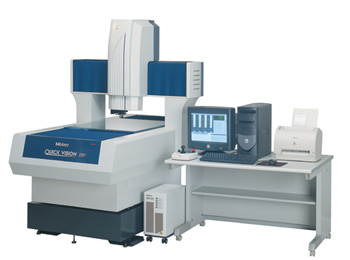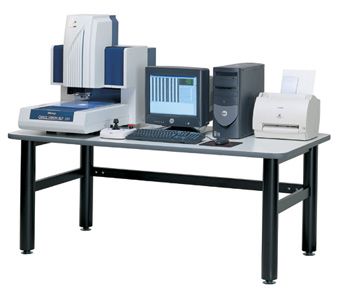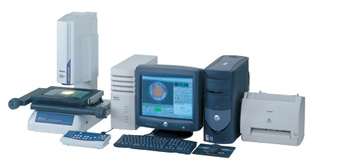|
"Quick Vision Series" Vision Measuring Systems Undergo Full Model Changes Introducing the "Quick Vision ELF Series" of Compact Measuring Systems Offering Superior Cost Performance |
|
Mitutoyo Corporation has adopted an all-new design for the "Quick Vision Series" of vision measuring systems in order to implement a full model change for its popular non-contact measuring systems, which have been accepted as the industry standard. We have also developed the new "Quick Vision ELF Series," which consists of compact models offering excellent cost performance. Sales of our revamped vision measuring systems family will officially begin on May 21, 2002. To commemorate the launch of the newly improved series, Mitutoyo will host its "2002 New Product Presentation and Exhibit" over a three-day period from May 29 (Wed) through 31 (Fri) at the Kawasaki R&D Center (inside the head-office building in Takatsu-ku, Kawasaki City, Kanagawa Prefecture), birthplace of the company's vision measuring systems. Immediately following its full-scale entry into the vision-measuring systems market in 1993, with the launch of the Quick Vision Series non-contact CNC vision measuring system, Mitutoyo moved into a position of leadership within the industry by actively improving its products in answer to diverse user needs. However, the remarkable technological innovation in so-called IT industries--namely the semiconductor and electronic-components sectors--continues to generate demand for vision measuring systems offering more advanced functionalities. Concurrently, the needs of individual users are becoming increasingly complex and diverse. To respond to this evolving marketplace, Mitutoyo has implemented a full model change for the Quick Vision (QV) Series by adopting an all-new design and state-of-the-art technologies, which reflect our vast accumulation of know-how with regard to vision-measurement and coordinate-measuring technologies. The company has also developed the Quick Vision ELF (QV ELF) Series, offering higher cost performance in the measurement of small parts. Additionally, Mitutoyo has revamped the "Quick Scope QS (CNC type)" and QS-L (manual type)" Series, the "Quick Vision ACCEL (QVA) Series" of space-saving, high-speed measuring systems adopting moving-bridge construction, and the "Vision Unit" models as an add-on function for microscopes. Together with the "Ultra Quick Vision (UQV) Series" of super-high-precision measuring machines, which offer the world's highest degree of accuracy, they comprise Mitutoyo's family of new, enhanced vision-measuring systems. The all-new Quick Vision (QV) Series offers significantly enhanced functions within a newly designed body. For a start, the series provides a higher operating speed (shorter measuring time) and energy-saving capability by adopting LEDs for all illumination units. The use of color LED illumination also facilitates measurements that would otherwise be difficult under white light. The models support four measuring ranges of 200, 300, 400 and 600 mm (X-axis), and three classes (Standard, Super, Hyper) offer different levels of measurement accuracy. In addition, our extensive line includes models supporting different measuring methods, such as the touch-probe measurement (contact measurement), laser point measurement and laser scanning measurement. The newly developed Quick Vision ELF (QV ELF) Series focuses on the measurement of small workpieces by limiting the measuring range (X x Y x Z-axes) to 200 x 200 (or 250) x 100 mm. Given that measurement accuracy is kept at the same level as the QV Series (standard models), the QV ELF Series yields excellent cost performance. Mitutoyo has also made significant improvements to the operation of the Quick Scope (QS, QS-L) Series--which are considered introductory models in the company's family of vision measuring systems--by raising the measurement accuracy to 3 mm (initial term value), increasing the range of Z-axis measurement to 50 mm for the manual type, and adopting a quick-release mechanism for the stage. The Quick Vision ACCEL (QVA) Series, characterized by its moving-gate construction, space-saving design and high-speed operation, has also been enhanced with a longer Z-axis measuring range of 150 mm compared with the previous 90 mm. The Vision Unit add-on systems also adopt new functions such as an automatic brightness control. Projected unit sales for each vision measuring system series are as follows:
[Key Features of the New Quick Vision Series and Quick Vision ELF Series] (1) Extensive Lineup The models cover six measurement sizes from small to medium, offer three levels of measurement accuracy (Standard, Super, Hyper), and support different measurement methods such as vision measurement, touch-probe measurement (contact measurement), TTL laser point measurement and laser scanning measurement (*1), allowing the user to select the best method for any particular need. Compact models offering superior cost performance are also available. (2) Sophisticated Illumination Units (New QV Series) All illumination units adopt an LED that reduces the measuring time by increasing the speed of response, thus saving energy. The reflected illumination unit, ring illumination unit and program-controlled ring light (*2) use color LEDs (red, blue, green and composite white), enabling a degree of edge detection (*3) that is difficult to perform using white light alone. The program-controlled color ring light offers a four-part illumination function and different angle settings to allow measurement in very small increments. (3) Flexible System Configuration Each function is designed as a module for connection via a network for the easy expansion of system capability. Along with an innovative design that requires less wiring, the intelligent control featuring a built-in microcomputer offers a self-diagnostic function for improved ease of maintenance. (4) Excellent Measuring Capability Several new features achieve high-performance measurements not heretofore possible, such as the sophisticated edge-measurement algorithm, the magnification switching function using a high-accuracy power turret (*4), and the illumination tools that quickly set the optimal illumination via the high-speed response characteristics of LEDs. The surface-focus function, which minimizes the effects of the measurement surface, and the grid-focus function ensure the stable, accurate measurement of height (*5). Through use of the double-pinhole method (*6), which reduces the effect an object's material may have on measurement, the TTL laser point measurement function (optional) delivers height measurement at high speed. The contact measurement function (optional) makes possible the measurement of solid shapes using a tough signal probe. When combined with Mitutoyo's laser indicator, the system facilitates high-speed, high-accuracy non-contact scanning measurement in the Z-axis direction (Quick Vision Hybrid type). (5) Optional Functions In addition to the aforementioned sensors (probes) and optional illumination units, the temperature compensation function (16 to 26ーC: standard accuracy) allows the system to be installed in the standard temperature environment used by the electronics industry (23ーC), as well as in general environments. The system can also be connected to a color CCD camera. [Key Features of the Quick Scope QS-L Series] (1) Shorter Measuring Time The stage adopts a quick-release mechanism (*7) that significantly reduces measuring time. (2) Greatly Improved Operability The Z-axis has large, single-shaft-type coarse/fine-feed focus handles on the right and left. The handle positions have been moved forward 22 mm for the sake of improved usability. Focusing ease was also significantly improved by setting the feed per handle rotation to 30 mm. (These features do not apply to the auto-focus type.) (3) Supporting a Wider Range of Measuring Objects With a minimum reading of 0.1 mm, the series supports objects requiring high-resolution measurement. The range of Z-axis measurement has also been increased to 150 mm (50 mm longer than the previous design) to accommodate objects of greater height. [Key Specifications of the New Quick Vision Series]
[Key Specifications of the Quick Vision ELF Series]
[Key Specifications of the Quick Scope QS-L Series]
[Explanation of Terminology] *1 - TTL laser point measurement, laser scanning measurement Laser-based height measurement functions include two types: The TTL (Through The Lens) type causes the laser point to run through the optical path generated by the objective lens, while the Quick Vision Hybrid type even allows the evaluation of shape via laser-beam scanning. *2 - Ring illumination, program-controlled ring light Two types of ring illumination are available: The program-controlled ring light allows control of illumination direction and angle, while the ring illumination allows control of illumination direction only. These illumination functions are available as factory options. *3 - Edge detection Position (edge) is detected from the contrast (brightness/darkness) information obtained via a CCD camera. *4 - Power turret Magnification can be switched between three levels--1x, 2x and 6x--via program control. The Quick Vision Series adopts a turret offering excellent magnification repeatability. *5 - Surface focus, grid focus Surface focus and auto-focus are each based on a method of image processing that allows the precise measurement of height and auto-focusing. In the grid focus mode, a pattern placed within the optical path is used to form an image on the workpiece surface, allowing the system to automatically focus on a transparent object or mirror surface having a low degree of contrast. *6 - Double-pinhole method The double-pinhole method, a newly developed detection principle using a laser probe, requires less directionality and is therefore less subject to the effects of scattered light than the general knife-edge method. The new models come equipped with a double-pinhole laser system. *7 - Quick-release mechanism The release mechanism provided next to a handle gives the user instant access to a floating stage. Thus it allows the user to perform measurement quickly without having to take his or her hand away from the handle area. |
 |
|
CNC Vision Measuring System Quick Vision: New QV606-PRO |
 |
|
CNC Vision Measuring System Quick Vision ELF: QV ELF250-PRO |
 |
|
Manual Vision Measuring System Quick Scope: QS-L1020Z/AF |
|
April 23,2002 |
|
|
|
[ Close ] |